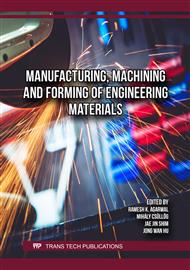p.13
p.21
p.31
p.37
p.45
p.51
p.59
p.67
p.75
Optimization of Strength & Roughness for Vapor Smoothened FDM Fabricated PLA Parts through Exposure Time and Temperature
Abstract:
Additive Manufacturing (AM) is considered a vital ingredient in Industry 4.0. Its manner of production is depositing material on a layer-on-layer basis. However, this manner of production normally generates undesirable layer lines. A common solution used to address this is a technique known as Vapor Smoothing (VS). VS is a modern process where chemical vapor is produced to contact the surface of Fused Deposition Modelling (FDM) fabricated parts. This would result in the disruption of part’s outer layers resulting in smoothening of its surface. This type of study has abundant Acrylonitrile Butadiene Styrene (ABS)-based research but currently lacks Polylactic Acid (PLA). Roughness is only one of the common criteria for a good FDM fabricated PLA part. Mechanical strength should also be considered as an acceptance criterion. Having said this, characterization such as Optical Microscopy with ImageJ processing; and tensile testing via Universal Testing Machine (UTM) were utilized. This research introduced a calculated response where good roughness can be attained without sacrificing too much strength in the form of an S/R ratio. It was identified that optimum vapor smoothing parameters are 55 degrees C with an exposure time of 4-min, where we were able to attain a roughness from 10.600 to 3.999 um roughness while having a reduction of strength from 46.1 to 42.7 MPa. As part of our recommendation, it would enhance the study if other characterization methods may also be applied to cite the effects of VS on mechanical properties such as fatigue, and flexural and compressive testing.
Info:
Periodical:
Pages:
45-50
Citation:
Online since:
June 2025
Authors:
Price:
Сopyright:
© 2025 Trans Tech Publications Ltd. All Rights Reserved
Share:
Citation:


